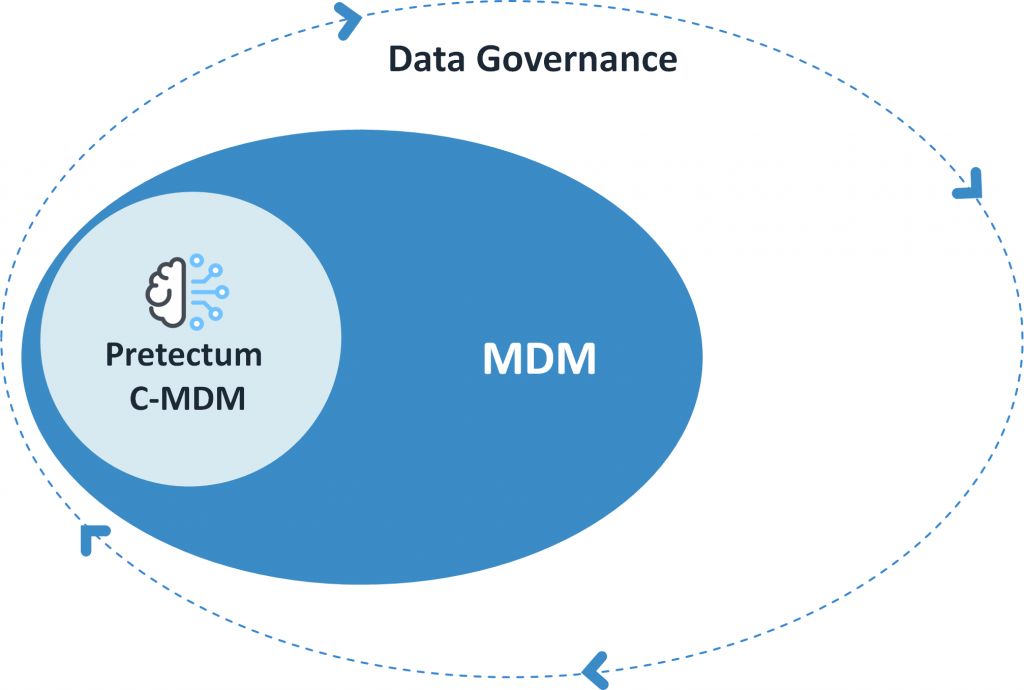Customer Master data management (CMDM) is the process of managing critical customer data assets within your organization to provide a single, trusted source of information in relation to customers.
A true cloud-native CMDM platform is built from the ground up to run on cloud infrastructure and services, leveraging modern technologies like NoSQL databases and managed services to deliver superior business benefits.

Compared to on-premise or cloud-hosted master data management models, a cloud-native platform offers several key advantages:
- Faster time-to-value and lower total cost of ownership, as the cloud provider manages the underlying infrastructure and services
- Improved scalability and responsiveness through auto-scaling capabilities to handle spikes in data and usage
- Greater business agility and flexibility through a microservices-based architecture and the ability to quickly adapt to changing requirements
- Enhanced reliability, availability and performance by taking advantage of provider-specific managed services
In contrast, “cloud-ready” or “cloud-hosted” solutions that simply migrate an on-premise system to the cloud do not provide the same level of cloud-native benefits and capabilities.
How Data Management Delivery Has Evolved
Master Data Management models have evolved to address diverse organizational data management challenges.
The on-premise data management model is the legacy enterprise software delivery model, installed locally on data centre infrastructure (servers, databases, OS). Monitoring, operating, backups, redundancy, failovers as well and upgrading the master data management software and hardware are the responsibility of the customer.

The on-premise model comes with a substantial CAPEX commitment and also claims a significant OPEX.
Security, scaling, and business continuity are fully managed by the customer, typically through their own IT or a resourcing arrangement with a managed services vendor.
Running an on-premise data management platform with a cloud provider is, for some companies, a shortcut to claiming they have a cloud-based one.
As the underlying architecture is the same as the on-premise version, they cannot leverage the full benefits of cloud services. Cloud-hosted data management is still challenging to upgrade and requires manual effort and considerable investment to manage the migrations.
Monitoring and maintenance of the hosting account are often the responsibility of the customer, reducing the benefits of being in the cloud.
Cloud-Native Customer Master Data Management
Cloud-native CMDM is built from the ground up to run on cloud infrastructure and services. Designed exclusively for the cloud, it can easily provision seamless upgrades and release cycles. In more modern cloud-native offerings like the Pretectum CMDM, capabilities are broken into smaller components called microservices, release cycles are faster without disruption to the business and monitoring and alerting are provided to improve service levels helping the cloud-native solution meet improved SLAs over on-premise and cloud-hosted data management solutions.
Scaling to meet growing business demands to handle peak capacity and varying performance requirements while managing infrastructure costs is a significant advantage and provides the best ROI.
Now, there is another interesting facet to this discussion topic, namely that of provider-native MDM where Cloud-native MDM is taken a step further to take advantage of provider-specific capabilities, improving reliability, availability, scalability, and performance.
Provider-specific capabilities including managed services run only on a single cloud provider. Pretectum CMDM makes use of this model too. The Pretectum CMDM application is developed on the AWS stack and this enables us to efficiently monitor, upgrade, and operationalize the service for all shapes and sizes of organizations.
When it comes to the lowest total cost of ownership, the Pretectum CMDM combination of cloud-native and provider-native customer master data management surpasses other models and market offerings.

A critical element in building a cloud-native solution because of its horizontally scalable nature, typical examples of NoSQL databases are Cassandra, MongoDB, AWS DynamoDB, and Google BigTable. NoSQL database technology enables horizontal scalability to add extra capacity when customer data workloads increase quickly. Helping scale to handle any volume of master data, this technology fully supports ingesting interaction data as well though we limit this in our context, to events within the CMDM platform itself.
The Pretectum CMDM cloud-native platform leverages multi-model data management to support both operational and analytic use cases. This provides agility to allow purpose-built services and components that can be used together to provide an enhanced customer experience for any use case. We believe that constraining the design to restrictive data integration and storage models typical of non-cloud data management solutions may prove to constrain opportunities for wider use, over time.
Changing business needs typically demand more flexible and comprehensive architectures. Pretectum CMDM’s platform is architected to support accordingly.


